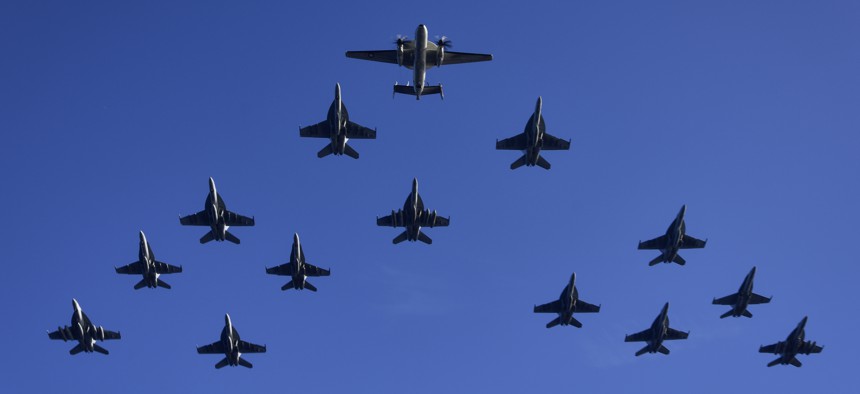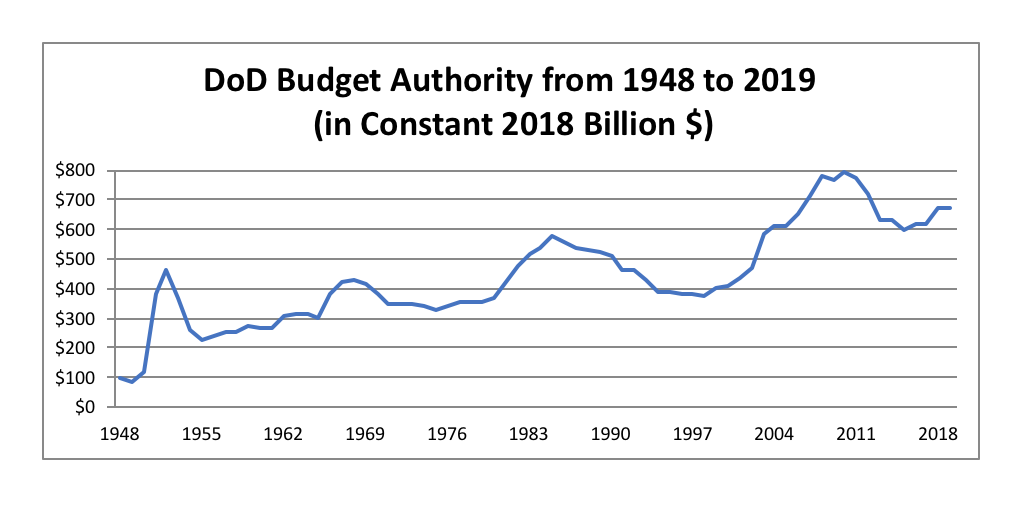
U.S. Navy and Marine Corps aircraft assigned to Carrier Air Wing 11 fly in close formation during a flight demonstration as part of Tiger Cruise 2017 aboard the aircraft carrier USS Nimitz (CVN 68), Nov. 30, 2017, in the Pacific Ocean. U.S. Navy photo by Mass Communication Specialist 3rd Class Emily Johnston
Putting the Pentagon's Pennies in Perspective
$80 billion is a lot of money. And that's just the "modest" increase on this year's defense budget.
Just three days after the President signed the the Bipartisan Budget Act of 2018 , granting the Pentagon near-historically high levels of funding, defense hawks were bemoaning Monday’s release of the President’s proposed $686 billion fiscal year 2019 Defense budget .
Just a “modest year-on-year increase,” they say , because “the 2 percent increase barely rises above inflation.” Yet the President’s budget adheres to the exact defense spending levels set in the Bipartisan Budget Act of 2018, which defense budget analyst Todd Harrison of the Center for Strategic and International Studies called “the upper limit of what anyone thought was possible.”
Context is often lost—at times, intentionally—when talking budget numbers, so just how much of an increase in Pentagon spending are we talking about?
For starters, it’s about an $80 billion increase in the Pentagon’s budget from 2017 to 2019. In real terms, that’s about 11 percent — a larger two-year increase than the DoD received during the height of the Reagan military buildup in the mid-1980s. To put this massive increase in perspective, here are a few other examples of what you could buy for $80 billion:
- Any country’s military for a year, save for China;
- Two U.S. State Departments ;
- The gross domestic product of any one of more than 100 countries ;
- Time Warner Cable ;
- Linkedin, Pinterest, Snapchat, and Twitter ;
- Donald Trump’s fortune 25 times over;
- A $245 check for every person in the U.S.
While the increase alone is staggering, the total amount of funding Congress and the President just agreed to give the military is truly impressive. According to historical data from the Department of Defense, and controlling for inflation, $686 billion is far more than President Reagan ever spent on the military during the Cold War and more than the U.S. military spent at the height of the wars in Vietnam and Korea. In fact, in all the decades after World War II, this level of military spending is second only to spending during the peak years of the wars in Iraq and Afghanistan.

What are we likely to get for this new flood of military funding? Will it make us safer, or will it just reinforce the Pentagon’s worst habits, enabling more waste, fraud and abuse and making it easier to soldier on in the wars without end?
On the one hand, after pressure from Congress and a network of organizations across the political spectrum, the Pentagon seems to be making a serious effort to get its books in order . This effort has already determined that the sprawling Defense Logistics Agency has lost track of $800 million in construction projects. More such revelations will no doubt be in the offing. But actually bringing the Pentagon’s finances to the point where they can pass an audit will be a lengthy undertaking, and it could be years before we know whether if the current effort will be successful.
Even without an audit, there are plenty of areas of waste that we already know about, like the $125 billion in excess bureaucratic overhead that the Pentagon tried to hide from Congress after it was uncovered by an agency advisory board, or the 600,000-plus poorly regulated private contractors employed by the Defense Department, many of whom do work that duplicates the efforts of government employees. If Defense Secretary Mattis takes real steps to eliminate redundancies of this kind, we’ll know that he’s serious about rooting out waste.
But even if the Pentagon passes an audit, the larger question of priorities will remain. Do we really need to spend $1.7 trillion (adjusted for inflation) on a new generation of nuclear weapons when the U.S. nuclear arsenal is already more than adequate to deter any nation from attacking the United States? Should we continue to fight wars in seven separate nations – Iraq, Afghanistan, Syria, Somalia, Pakistan, Libya and Yemen – and arm more than half the nations on the planet? Until these kinds of questions are answered, no amount of money will be enough to make America and its allies safe in an increasingly complex world, one that includes many challenges that don’t lend themselves to military solutions. More money alone is not the answer, and could even make matters worse. The challenge of aligning the Pentagon’s massive budget with the nation’s most pressing security needs remains to be addressed.



